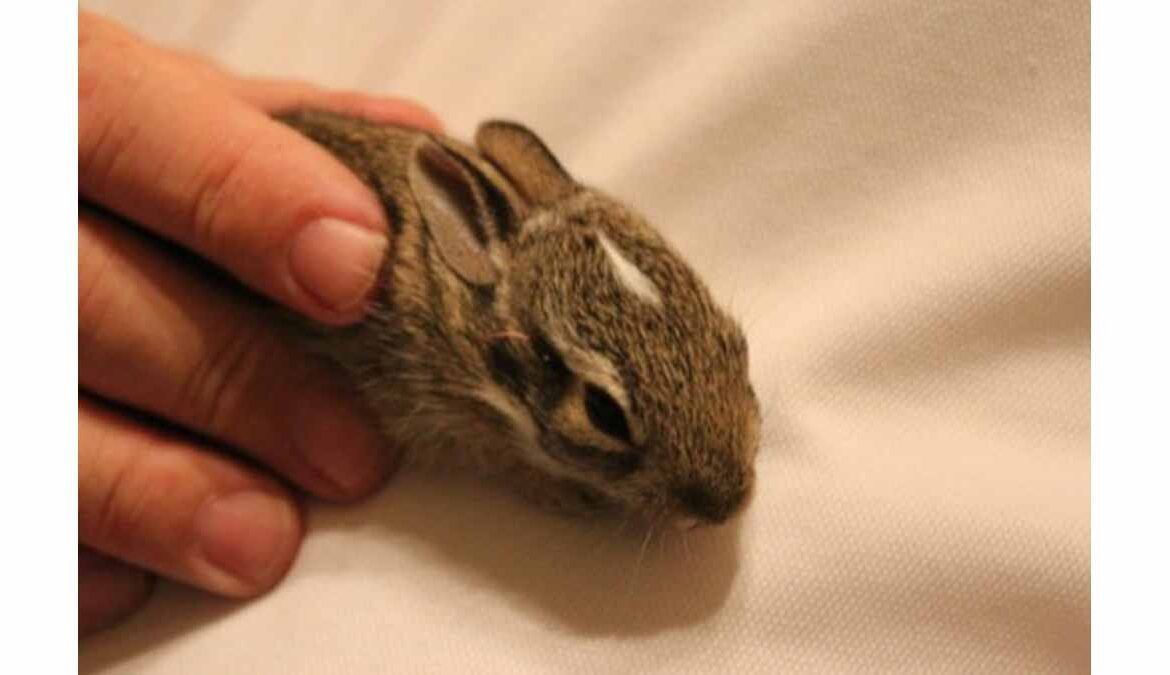I am currently growing the world’s most expensive green beans. While the beans aren’t really anything special, they have already cost me well over $100 this spring. My super expensive green beans are a variety of flat bean called Navarro. Bill Adams introduced me to these beans a couple of years ago and I like them so much they are now the only variety I grow. Well, let me rephrase that. Navarro flat beans were the only beans I was growing – until the bunny showed up.
I saved this little bunny a few years ago. maybe it grew up to be our afternoon visitor
Most evenings, my wife and I sit out in the yard with her father and watch the seasons change. About a year and a half ago an unusually friendly cotton tail started showing up and visiting with us. The rabbit would hop right up in front of us and then graze on my St. Augustine. Within a few weeks we discovered this friendly bunny was a girl. Before long we had two very sociable cotton tails joining us every night.
I think you see where this is going. We got attached to the bunnies. Unfortunately our friendly little bunnies did what they do and before long I could no longer grow green beans in the garden. I am not kidding. Last spring, I planted my 35 by 4 foot bed of Navarro flat beans three times. I harvested exactly zero beans. Then in the fall I planted again. You guessed it, no beans.
Getting my garden ready for my first attempt at growing under cover.
Since I have discovered that my wife is a HUGE fan of cotton tails, I have been forced to invest in some (expensive) hoops and nets that will allow me to grow my beans and allow her to continue watching the bunnies. I have never grown anything under cover before. So, instead of getting upset, I am looking at my new hoops as both an investment and a learning opportunity.
I am pretty happy with my fiberglass hoops from Mr. Garden
While I am complaining about the bunnies, I am pretty excited about learning how to grow under cover. Bunnies aren’t the only pests in my garden. In fact, until this spring, the squash vine borer had forced me to give up growing zucchini and yellow squash. Thanks to my new hoops I now have a full row of beans and half a row of both squash planted.
Right now I am in the honeymoon phase of growing under cover. I bought two products from Amazon to build my hoops. The actual hoop is a six foot long fiberglass pole called the DURAHOOP by Mrgarden.net. I bought 20 of the hoops. ). So far I have been very pleased with this product. The thin, flexible fiberglass rods are very easy to use. The only down side is the fiberglass part. Because they are fiberglass you need to wear gloves when handling them. I did not and I got lots of painful and itchy fiberglass shards in my hands. Other than that, they worked perfectly. I used my tape measure to create two identical arcs at each end of my row. Then I ran strings on both sides and placed the other arcs five feet apart. I then ran a single rod over the top of the arcs and tied them all together with zip ties.
I believe zip ties are the greatest invention ever! I use them for everything, including tying my hoop frames together.
Once the hoops were assembled I covered them with Summer Lightweight Garden Fabric from Green Valley Supplies. This product is designed to allow in water and light and add a little shade as it (hopefully) keeps the bunnies and vine borers away from my young plants. The fabric is eight feet wide and 45 feet long. My wife and I stretched the fabric over the hoops, then bunched the extra fabric up on the sides and held that down with rebar. At the ends we gathered the fabric together and closed it with zip ties. We held these bunched ends down on the ground with bricks.
My row cover is from Green Valley Supplies. While it is a little fragile, I have high hopes it will do what I need it to.
I have to admit, I am a little disappointed in the row cover. While I think it will work, it was kind of fragile. The zip ties that we used to tie the frames together poked two holes in the fabric that resulted in tears. Since I have not used row cover before I am not sure if all row cover performs like this or if I should have been more careful assembling my hoops. Regardless, I am fairly confident that the row cover will keep the bugs and bunnies away.
I am very excited about my row cover experiment. We have had 18 mph winds this week and they have held together beautifully.
Since this is my first attempt at growing under cover, my basic plan is to grow the beans and the squash under the fabric until they flower. I have heard that once the plants get this big they can usually survive both the vine borer and the rabbits. However, if this is not true, be sure to leave me a comment. Like I said, this is an experiment and I would love to hear any and all tips from any of you that have been successful with this.
BTW, bluebonnet season is now in full swing in Washington County. If you look forward to riding around and taking pictures of our state flower, then the next two to four weeks will be spectacular. Happy spring y’all!!!
Our grandson came for a visit this past week. We could not resist taking a few pictures of him in the bluebonnets!








